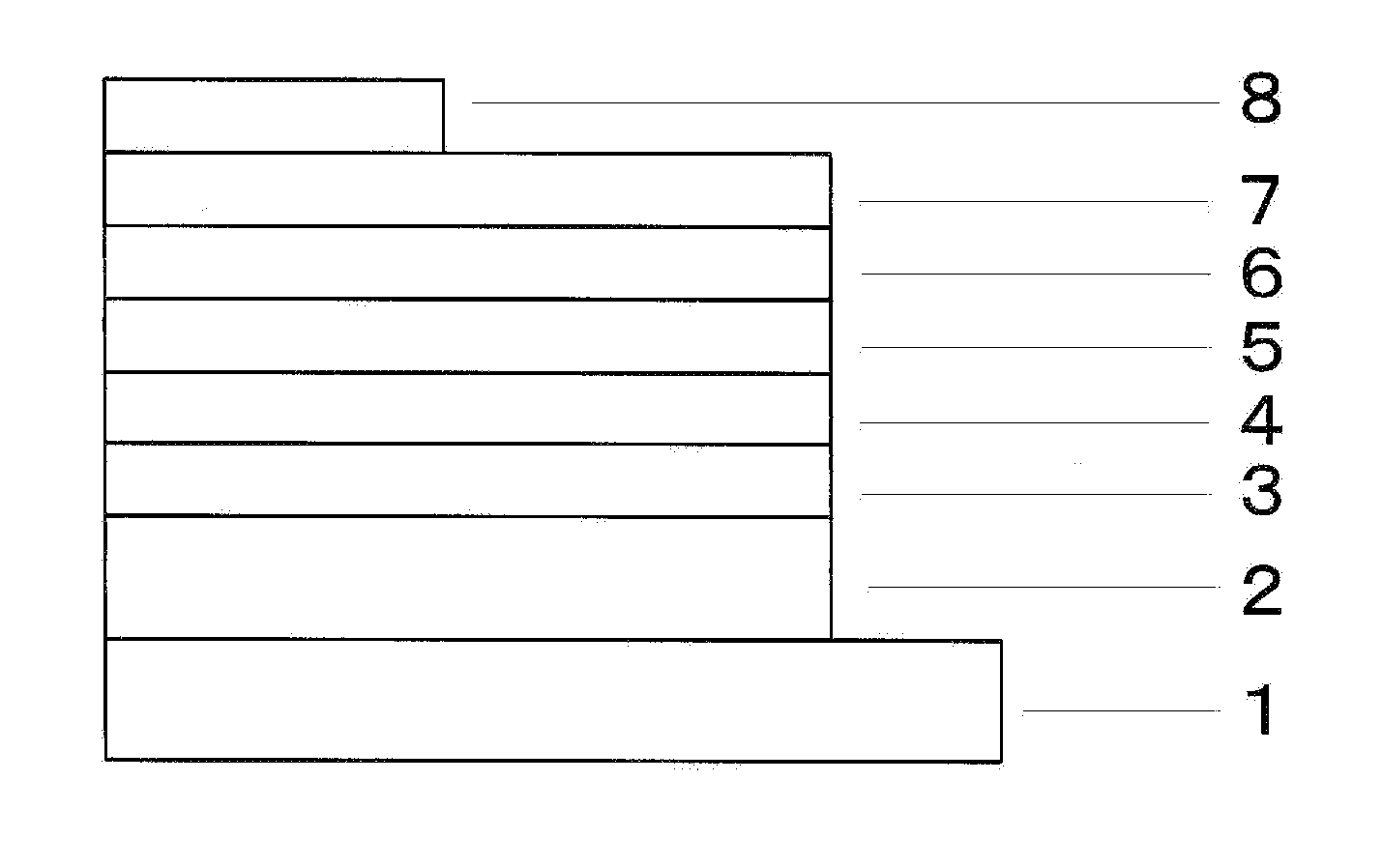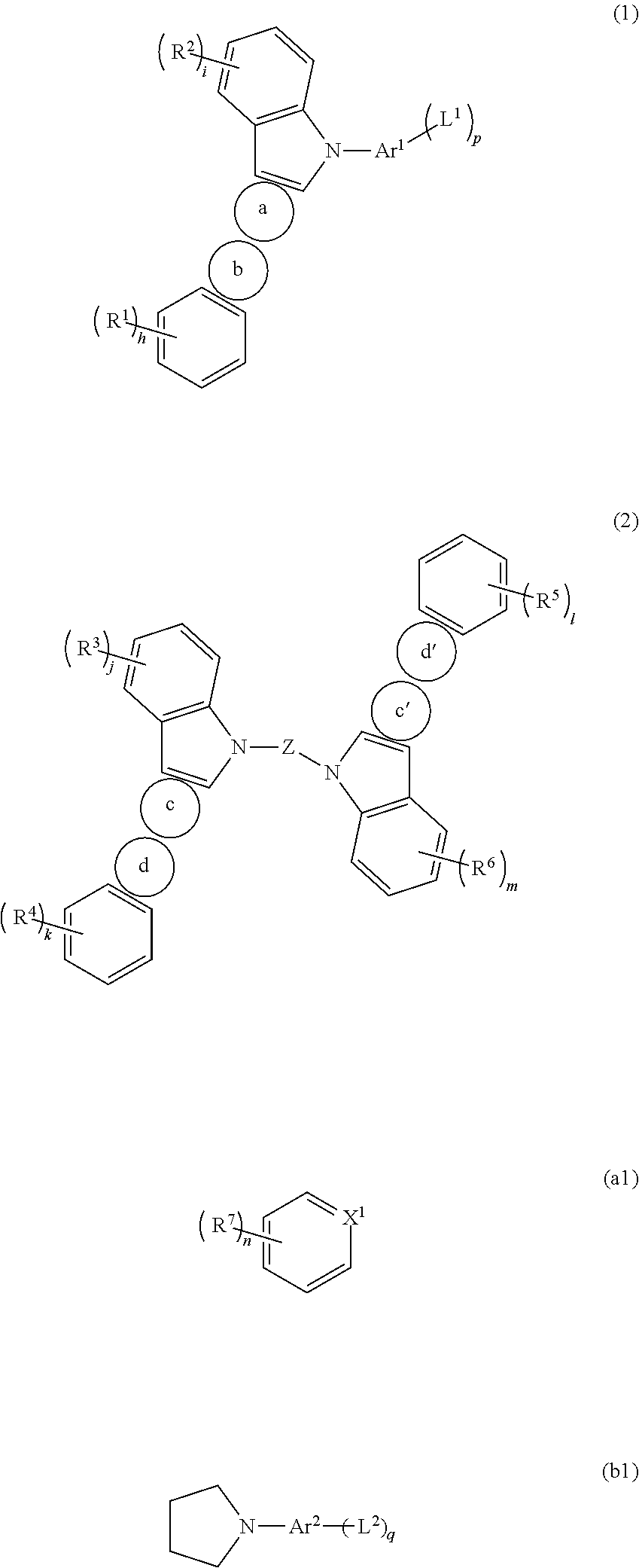Organic electroluminescent device
a technology of electroluminescent devices and organic materials, applied in organic chemistry, organic semiconductor devices, luminescent compositions, etc., can solve the problem of not achieving high-efficiency light emission, and achieve the effect of long life and high efficiency
- Summary
- Abstract
- Description
- Claims
- Application Information
AI Technical Summary
Benefits of technology
Problems solved by technology
Method used
Image
Examples
example 1
[0109]Each thin film was stacked by a vacuum deposition method at a degree of vacuum of 4.0×10−4 Pa on a glass substrate on which an anode formed of ITO having a thickness of 150 nm had been formed. First, copper phthalocyanine (CuPC) was formed into a hole-injecting layer having a thickness of 20 nm on the ITO. Next, 4,4-bis[N-(1-naphthyl)-N-phenylamino]biphenyl (NPB) was formed into a hole-transporting layer having a thickness of 20 nm. Next, Compound 1-2 as a first host, Compound 3-87 as a second host, and tris(2-phenylpyridine)iridium(III) (Ir(PPy)3) as a light-emitting layer guest were co-deposited from vapor deposition sources different from one another to form a light-emitting layer having a thickness of 30 nm. At this time, a vapor deposition rate ratio among the first host, the second host, and Ir(PPy)3 (volume rate ratio among vaporized products) was 47:47:6. Next, aluminum(III) bis(2-methyl-8-quinolinato)4-phenylphenolate (BAlq) was formed into a hole-blocking layer havin...
examples 2 to 4
[0111]Organic EL elements were each produced in the same manner as in Example 1 except that in Example 1, a compound shown in Table 1 was used as the light-emitting layer second host. An external power source was connected to each of the resultant organic EL elements and a DC voltage was applied to the element. As a result, an emission spectrum having a local maximum wavelength of 517 nm was observed for each of the organic EL elements and hence it was found that light emission from Ir(PPy)3 was obtained. The luminance, external quantum efficiency, and luminance half lifetime of each of the produced organic EL elements are shown in Table 1.
example 5
[0119]Each thin film was stacked by a vacuum deposition method at a degree of vacuum of 4.0×10−4 Pa on a glass substrate on which an anode formed of ITO having a thickness of 150 nm had been formed. First, CuPC was formed into a hole-injecting layer having a thickness of 25 nm on the ITO. Next, NPB was formed into a first hole-transporting layer having a thickness of 10 nm, and 4,4′,4″-tris(N-carbazolyl)-triphenylamine (TCTA) was formed into a second hole-transporting layer having a thickness of 10 nm. Next, Compound 1-114 as a first host, Compound 3-87 as a second host, and tris[1-14′-cyanophenyl)-3-methylbenzimidazol-2-ylidene-C2,C2′]-iridium(III) (Ir(cn-pmic)3) as a light-emitting layer guest were co-deposited from vapor deposition sources different from one another to form a light-emitting layer having a thickness of 30 nm. At this time, a vapor deposition rate ratio among the first host, the second host, and Ir(cn-pmic)3 was 45:45:10. Next, 2,9-dimethyl-4,7-diphenyl-1,10-phenan...
PUM
| Property | Measurement | Unit |
|---|---|---|
| ionization potential | aaaaa | aaaaa |
| visible light transmittance | aaaaa | aaaaa |
| visible light transmittance | aaaaa | aaaaa |
Abstract
Description
Claims
Application Information
 Login to View More
Login to View More - R&D
- Intellectual Property
- Life Sciences
- Materials
- Tech Scout
- Unparalleled Data Quality
- Higher Quality Content
- 60% Fewer Hallucinations
Browse by: Latest US Patents, China's latest patents, Technical Efficacy Thesaurus, Application Domain, Technology Topic, Popular Technical Reports.
© 2025 PatSnap. All rights reserved.Legal|Privacy policy|Modern Slavery Act Transparency Statement|Sitemap|About US| Contact US: help@patsnap.com



